Lemon Thyme: Care and Growing Guide (With Pictures)

Lemon thyme is an aromatic herbaceous bushy shrub with lemon-scented edible leaves and small, tubular, purplish-pink flowers. The resilient subshrub, with its fragrant oval leaves, has many landscaping and culinary uses. Its low growth, evergreen foliage, and resistance to drought and heat make it a great addition to any garden landscape. Additionally, you can harvest its leaves to use in cooking.
How easy is it to grow lemon thyme in a front or backyard? What are the basic care requirements for this fragrant Mediterranean woody shrub?
This identification care guide for lemon thyme answers these questions and more. In addition, at the end of the article, you will get helpful tips on resolving common problems growing lemon thyme in your herb garden.
What is Lemon Thyme (Thymus citriodorus)?
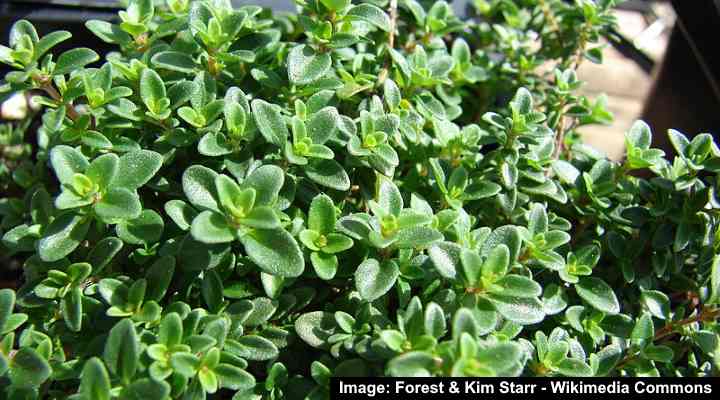
Lemon thyme (Thymus citriodorus) is a low growing evergreen flowering dwarf shrub with aromatic leaves
Lemon thyme is a small, compact shrub in the genus Thymus and mint family Lamiaceae. The aromatic shrub boasts cheerful chartreuse-tinged evergreen foliage and an elegant citrusy aroma when the leaves are crushed. The lemony-earthy aromatic herb blooms in early summer with whorls of lavender-pink blossoms.
Also called citrus thyme, the herby shrub grows 6” to 12” (15 – 30 cm) tall and 12” to 18” (30 – 45 cm) wide. The shrub is identified by its compact growth, rounded, bushy appearance, and bright green leaves which can sometimes have yellowish margins.
Lemon thyme is an attractive shrub that performs well in full sun and dry to medium soil. The long-blooming lilac-pink flowers attract beneficial insects such as ladybugs and hoverflies. In addition, pollinators like bees and butterflies are attracted to the fragrant flowers and regularly feed on the flower nectar.
Lemon thyme is classified as a herbaceous evergreen shrub suitable for warm, dry climates. Due to its compact nature and low growth, this citrus thyme variety is suitable for gardens of all sizes. It’s perfect as an edging plant along a driveway or growing in containers to spruce up a patio or decking area.
Lemon thyme (Thymus citriodorus) should not be confused with low-growing, spreading shrub, also called lemon thyme (Thymus pulegioides). However, it is not uncommon in the botanical world for plants to have similar common names. This is why it’s always a good idea to check the botanical name when choosing plants to grow in your garden landscape.
How to Care for Lemon Thyme
To care for lemon thyme, plant the shrub in full sun, where the soil drains well and is relatively fertile. Citrus thyme thrives in dry conditions; therefore, it only requires watering every two weeks or so. There is no need to fertilize lemon thyme growing in the ground.
Lemon Thyme Flowers

Lemon thyme (Thymus citriodorus) flowers
Flowers on lemon thyme shrubs are clusters of tiny lavender-pink, mauve, or light purple blossoms. The colorful, decorative edible flowers bloom in early summer and persist until fall. The small pinkish tubular flowers are an important nectar source for bees and butterflies. Like the plant, lemon thyme flowers have a citrusy aroma.
Lemon Thyme Leaves
Lemon thyme foliage consists of tiny lemon-scented leaves that are oval to lance-shaped. Many varieties of lemon thyme have dark green leaves with colorful yellowish or creamy white margins. This evergreen foliage gives lemon thyme tremendous landscaping value in herb gardens, borders, and containers.
Variegated Lemon Thyme Leaves
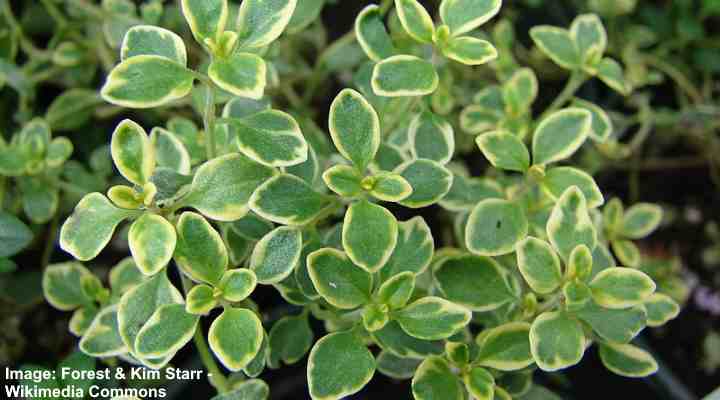
Variegated leaves of lemon thyme
Some of the most eye-catching lemon thyme shrubs have variegated leaves. Variegated lemon thyme shrubs have chartreuse leaves with silvery margins, and others have lime-scented green leaves with yellowish edges.
Varieties of variegated lemon thyme cultivars include the following:
- Thymus citriodorus ‘Variegata’ — Light green leaves with silvery margins.
- Thymus citriodorus ‘Silver-Edged’ — Leaves with thin silver margins contrasting with pink flowers.
- Thymus citriodorus ‘Creeping Golden Lemon’ — This creeping lemon thyme has variegated green and gold leaves with lavender flower spikes.
Creeping Lemon Thyme (Thymus pulegioides)
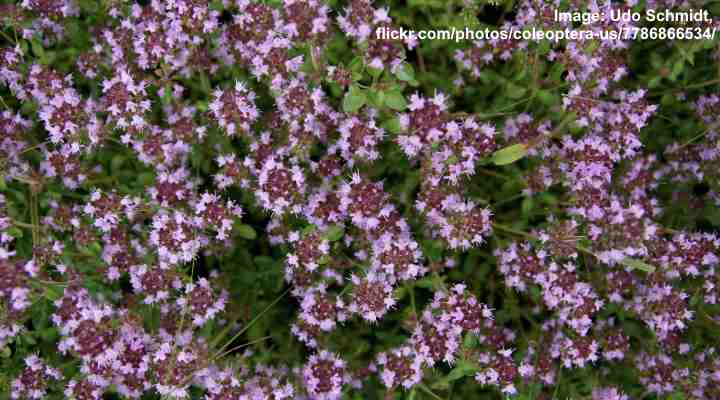
Creeping lemon thyme (Thymus pulegioides) has a spreading nature and is grown as a ground cover plant
Creeping lemon thyme is a spreading dwarf shrub with reddish woody stalks, rose-pink tubular flowers, and dark green, sometimes variegated, leaves. Also called broad-leaved thyme, the creeping shrub looks like wild thyme (Thymus serpyllum). However, it has larger, broader leaves on the woody shoots.
Creeping lemon thyme grows 2” to 10” (5 – 25 cm) tall and up to 10” (25 cm) wide. The ground-hugging, horizontally spreading shrub has uses in landscapes as ground cover plants for full sun, container planting, or growing in hanging baskets.
Lemon Thyme Uses in the Landscape
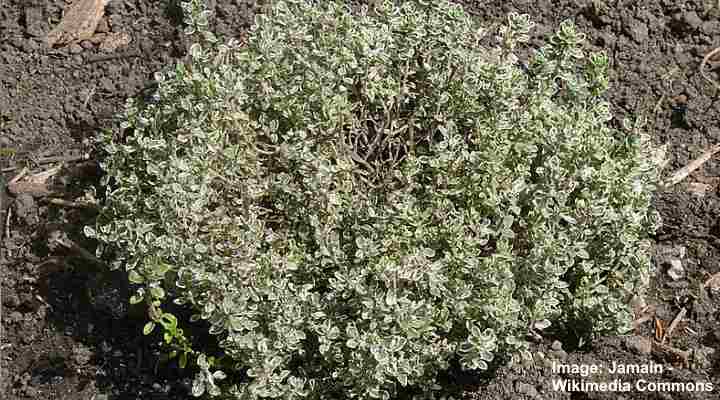
Lemon thyme is a versatile landscaping shrub. In the picture: Variegated lemon thyme shrub
Lemon thyme is a valuable landscaping herbaceous shrub. It has bushy, evergreen foliage, compact, upright growth, and a strong lemony scent. Additionally, it grows in most soils in full sunshine if the ground has excellent drainage. Additionally, the pinkish tubular flowers add a splash of color throughout the summer.
Therefore, lemon thyme is a great choice for use in the landscape because of its attractive foliage, fragrant blooms, and low maintenance requirements. You can grow the small aromatic shrub as ground cover, edging, foundation plantings, shrub borders, low-growing hedges, or container plants.
Furthermore, it’s easy to propagate from cuttings, so you’ll have plenty of new plants on hand when your current shrubs outgrow their space.
In addition to its attractive visual appeal, lemon thyme is ideal for planting in herb gardens. You can harvest the leaves and use them in salads, stews, soups, and Mediterranean dishes. Also, the strong citrus taste from the leaves complements dishes that include tomatoes, garlic, and olive oil.
Lemon Thyme as Ground Cover
It’s easy to grow lemon thyme as ground cover in sunny spots in your garden. Planted en masse, the low-growing shrub, with its scented foliage, helps to cover bare patches. However, its growth is primarily upright, which means it is not the best choice for spreading over the ground.
Suppose you are looking for a flowering thyme variety with creeping growth. In that case, you could look for wild thyme or Breckland thyme cultivars (Thymus serpyllum).
Lemon Thyme Identification
Lemon thyme is identified by its small dark green or chartreuse leaves, clusters of tiny purple-pink tubular flowers in summer, and compact, upright growth. As a result, lemon thyme looks like regular thyme shrubs. But you can tell the difference by crushing the leaves and enjoying its citrusy aromas.
Where to Plant Lemon Thyme in the Landscape
The best place to plant lemon thyme in the garden is a sunny spot with good drainage. Citrus thyme grows best in dry, sandy, rocky soils and will tolerate poor soils and drought. However, it’s good to note that lemon thyme performs poorly in damp ground and shade.
Lemon thyme is suitable for growing in USDA zones 6 through 9. To grow well, the planting location should get at least six hours of sunlight daily. And although fertile soil is preferable, the hardy shrub will adapt to almost any type of dry soil.
Lemon Thyme Propagation
The easiest way to propagate lemon thyme is by rooting stem cuttings or dividing the plant. It is possible to grow lemon thyme from seeds, but they can take a long time to germinate.
Here are instructions to propagate lemon thyme shrubs.
Growing Lemon Thyme From Seed
To grow lemon thyme from seed, start them in late winter or early spring.
First, fill some seed-starting pots with moist peat moss and put two or three seeds in each small pot. Then cover them with plastic wrap and put them in a sunny spot near a bright window. Mist the soil daily to keep it moist.
When lemon thyme seedlings appear, remove the plastic wrap. Keep the soil moist. Transfer the thyme to individual pots when the seedlings have grown to 3” (7.5 cm) tall.
You can then transfer the tiny shrubs to the garden once they are 4” to 5” (10 – 12.5 cm) tall and any threat of frost has passed.
Water the newly-planted lemon thyme shrubs for the first few months to help establish the roots.
How to Plant Lemon Thyme Cuttings
To grow lemon thyme shrubs from cuttings, take stem cuttings 3” to 4” (7.5 – 10 cm) from established plants in early spring. First, remove the leaves from the bottom half of the stem, leaving two or three at the end. Next, place the cutting into a small pot containing well-draining potting soil.
Ensure that the cutting is about 2” (5 cm) in the soil and firm the soil around the stem. Then, water the stem cutting thoroughly. After that, place the pot in a bright location but out of direct sunlight and keep the potting medium evenly moist.
After four to six weeks, you should notice new leaves growing. When you see the new growth, you can transplant the lemon thyme shrub cutting to the garden and grow in a sunny spot.
Propagating Lemon Thyme Shrubs by Division
You can grow more lemon thyme plants in your garden by dividing an established, mature shrub. You can divide lemon thyme in early spring or late fall. Here is what you should do.
Dig up the plant, ensuring you get all the roots, and shake off excess soil. Next, it’s necessary to break apart the plant’s root system into three or four smaller pieces. Finally, take care of the roots when untangling them to cause as little damage as possible.
The next step is to plant your new shrubs in the sunniest part of your garden. Propagating lemon thyme by division is an excellent way to establish an evergreen low hedgerow. Plant the shrubs as edging along a pathway, or grow in containers to decorate an entranceway
Growing Lemon Thyme in Pots
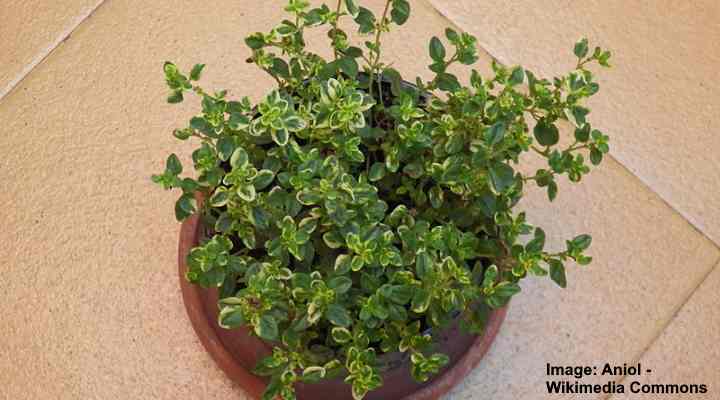
Potted lemon thyme
Lemon thyme is a miniature herbaceous evergreen shrub that thrives in pots. The potting soil should be moderately fertile and amended with perlite for extra drainage. Also, the pot — ideally a terracotta pot — should have several drainage holes in the base to help keep the potting soil from becoming soggy.
To care for a potted lemon thyme plant, water the soil whenever the top 3” (7.5 cm) is dry. Then thoroughly water it until the excess drains from the holes in the pot. Finally, keep the potted citrus thyme shrub in a sunny location.
Lemon Thyme Care Guide
Lemon thyme is one of the easiest herbs to grow. Growing in moderately dry, well-drained soil in a sunny spot is the most important care requirement for this citrus-scented herb.
Here are some top tips when growing lemon thyme in a landscape.
How to Water Lemon Thyme
The only time you must water established lemon thyme shrubs is when the ground is parched. You can then water the soil to thoroughly drench it, ensuring that the moisture reaches the deep roots. In hot summers, you may only have to water lemon thyme once or twice a month.
However, new plantings require regular watering for about a couple of months to get established. After that, you can reduce the watering frequency to whenever the top two inches of soil are dry. However, you rarely have to water a lemon thyme shrub if you get occasional rainfall.
Lemon Thyme Temperature and Humidity
Lemon thyme performs best in warmer temperatures with low humidity. These conditions ensure that the aromatic shrub blooms throughout the summer, adding a pop of purple colors to your garden landscape. Also, warm, dry weather ensures the citrusy essential oils are released into the air, filling the garden with lemon scents.
In cooler climates in zones 5 and 6, lemon thyme goes dormant over winter. However, the shrubs typically retain their foliage, keeping plenty of green colors in your yard from November through spring.
If you’re growing lemon thyme indoors, keep the temperature between 65°F and 85°F (18°C – 29°C). The shrubby herbs need moderate humidity indoors. Additionally, the thyme shrub thrives indoors when they get around five hours of sunlight daily.
Pruning Lemon Thyme Shrubs
Lemon thyme has minimal care requirements, including pruning. You can cut back stems after flowering to encourage new growth. However, most gardeners leave the shrub to grow naturally.
Should You Fertilize Lemon Thyme?
Lemon thyme growing in the ground doesn’t require fertilization. The plant adapts well to poor, nutrient-deficient soils. However, they perform best in average soil. Therefore, incorporating a little organic compost can help promote overall plant health.
Problems Growing Lemon Thyme in the Garden
Lemon thyme is a tough, resilient shrub, and healthy plants are rarely affected by pests or diseases. However, sometimes, aphids or spider mites may become a minor nuisance. And if you water the shrub too much, you may notice signs of fungal diseases.
Here are some solutions to common issues affecting lemon thyme growth.
Aphids: These pests are more of a nuisance and won’t severely harm the growth of lemon thyme. They’re small, light green bugs found on the underside of leaves. Signs of aphids on plants can be leaf curling, yellowing, or wrinkled, brittle leaves.
To get rid of aphids from lemon thyme, give the shrub short sharp blasts with the garden hose to dislodge the critters.
Spider mites: Spider mites are hard to spot on lemon thyme shrubs. However, the good news is that they won’t cause significant damage to your herbs. Signs of spider mites are tiny web-like strands hanging from leaves.
You can get rid of spider mites the same way as aphids — blast them with water from a hose.
Foliar diseases: Signs of fungal disease like yellow leaves, dieback, or poor growth typically occur in warm, humid climates. This can also be a result of poor soil drainage or overwatering.
To avoid slow growth, let the soil dry out between waterings. And, when you water the shrub occasionally, always water the ground thoroughly and avoid splashing water on the leaves.
Also, staking the upright stems can help prevent leaves from coming into contact with the ground and getting fungal or bacterial diseases.
If you notice signs of rot, then it’s necessary to remove all affected stems and foliage and destroy them.
Harvesting and Preserving Lemon Thyme Leaves
The time to harvest lemon thyme leaves is in the morning or just after sunset. However, you can harvest the aromatic leaves and stems at any time of year. All you have to do is snip a few inches of the stems just above a node.
To preserve your citrusy, herbal leaves, bundle several twigs of lemon thyme, tie them with twine, and hang them in a dark, warm place to dry completely. Alternatively, you can oven-dry them at a low temperature for two to four hours.
Related articles:
